
Environmental Toxins
Learn how
environmental toxins affect our air, our water, our food
and our bodies. And the risks that we are exposed to daily, and how to counter
react these toxins.
Introduction

www.lesstoxicguide
We live in a chemical world. Over 50,000 chemicals have entered daily use
since World War II, many of them found in the products we use every day to
clean and beautify our bodies and our homes. Some of these chemicals are
linked to cancer; others may disrupt the delicate endocrine system; and
others may compromise our immune system or our central nervous system.
Scientists are
increasingly concerned that long-term low-level exposures to chemicals
create a variety of health risks. They also worry that we do not yet know
the impact of living with the cocktail of chemicals found in household air
and dust. Testing for human health effects is normally done on single
chemicals, but in the real world, we are all exposed to a variety of
chemicals every single day.
Identifying less toxic products among the thousands of products lining the
shelves of grocery stores, pharmacies and health food stores, garden centers
and home improvement stores can be difficult.
Many people assume that
“if it was bad for us, the government would not allow it to be sold.” But we
know that regulatory bodies are slow to act.
Legislation governing pest control products was only amended in 2002, after
over 30 years without change. And Health Canada has been slow to restrict
many chemicals currently in use, including known or suspected carcinogens,
hormone disruptors and reproductive toxins.
It maintains a ‘hot list’ of chemicals restricted in cosmetics, but even
chemicals, officially declared "toxic", including known carcinogens such as
hydroquinone, are still allowed in personal care products.
Evaluating and regulating all the chemicals we use in our daily lives is a
slow process and past experiences in regulating lead in gasoline, tobacco
and lawn pesticides tells us that the companies which produce these products
won’t take attempts to limit their use quietly.
In choosing the products we use on our bodies and in and around our
homes WE are the ones in control.
We can make informed choices for the sake of our own health and the health
of our families. And in most cases, what is less toxic for us is also less
toxic for the natural environment.
top
Alarming
Statistics

ndnr.com
-
© Copyright Naturopathic Doctor News &
Review. All Rights reserved
As far as other environmental toxins, the list of detrimental chemicals
continues to increase. The 2010 release of the Fourth National Report on
Human Exposure to Environmental Chemicals by the Centers for Disease Control
and Prevention7 provided
a 529-page comprehensive data assessment on the burden of chemicals to the
health of the US population. Among the chemicals included in the list were
metals, herbicides, fungicides, polycyclic aromatic hydrocarbons, and
parabens.
For the first time in the CDC’s biannual 2-year report, 75 new chemicals
were found in urine and serum samples of 2400 participants. New chemicals
that were included in this compilation were acrylamide, arsenic,
environmental phenols (including bisphenol A and triclosan), and
perchlorateorate. The burden on our patients is likely extreme, as the
National
Health and Nutrition Examination Survey
reported an estimated
average of 212 chemicals in any one person’s blood or urine sample.7
This translates to an increasing burden on all the major organs of
elimination, including lungs, kidneys, liver, colon, and skin.
What
is of more concern is that,
as our
population becomes sicker, they face greater exposure.
Therefore, it is
important that we protect ourselves and our patients from these factors as a
form of preventive medicine. Here is where our nature roots can gleam:
the often-criticized obsession with the gut may be our biggest tool to
eradicate this major stressor in an overwhelmed population. A place to
start is where most major detoxification occurs, the liver.
www.psr.org -
© Copyright
Physicians for Social Responsibility
The Toxic Substances Control Act (TSCA) is the
principle law for managing chemicals in the U.S. This law was enacted in
1976 to provide a regulatory frame work for the U.S. Environmental
Protection Agency (EPA) to address
chemicals throughout their life cycle.
TSCA was heralded as a major step forward in providing urgently
needed authority to protect human health and the environment from dangerous
chemicals. However, 34 years on, policy makers and public health experts
agree that TSCA
has failed.
One of the failings of TSCA is that it
lacks mandatory safety requirements before a chemical can gain access to
market.
TSCA gives legal authority to the EPA to ban the manufacture and import of
those chemicals that pose an unreasonable risk to human health or the
environment. However, when TSCA was enacted it grandfathered in 62,000
chemicals in use at that time (“existing chemicals”), and since then, less than 200 of
these have been tested for human safety -- while only five have been banned
since 1990. In
fact, the EPA has reviewed the human health risks of only an estimated 2% of
the 62,000 chemicals that were in use in 1976. Consequently, the vast
majority of existing chemicals have never been evaluated for potential
toxicity (beyond acute toxicity) to infants, children, developing fetuses,
or adults…
EPA’s 1998 Chemical
Hazard Data Availability Study revealed
that although nearly 3,000 chemicals have High Production Volume status in
the United States (defined by the EPA as imported or produced at one million
pounds per year or more), complete basic toxicity profiles (covering acute,
sub-chronic, chronic, developmental, and reproductive toxicity, as well as
mutagenicity) were available for only 7% of these.
www.doctoroz.com © Harpo, Inc., All Rights Reserved
...Approximately 46% dentists
in the United States still use mercury-containing dental amalgam…
Once believed to be “locked into the filling itself,”
mercury vapor is now widely recognized to be
emitted from the filling surface …
A 2006 poll of 2,590 US adults found that 72% of
respondents were not aware that mercury was a main component of dental
amalgam, and 92% of respondents would prefer to be told about mercury in
dental amalgam before receiving it as a filling. ..
In 1991, the World
Health Organization (WHO) confirmed that mercury contained in
dental amalgam
is the greatest source of mercury vapor in non-industrialized settings,
exposing the concerned population to mercury levels significantly exceeding
those set for food and for air. WHO also went on to state that
mercury contained in dental amalgam and in laboratory and medical devices
accounts for about 53% of total mercury emissions – and about
one-third of the mercury in the sewage system comes from dental amalgam
flushed down the drain.
Reference
-
www.mercurypolicy.org
-
© Mercury Policy Project
Dental mercury
releases from clinics are the largest contributor of mercury to municipal
wastewater treatment plants in the U.S. and are a significant contributor of
mercury emissions to the environment and the fish Americans eat. Between
25 and 34 tons of mercury are used in mercury-based dental fillings each year to
fill tooth cavities, and half of all mercury still used in commerce is in
Americans’ mouths -- about 1,000 tons.
ndnr.com -
© Copyright Naturopathic Doctor News & Review
The Environmental Protection Agency states the
following in their Chemical Hazard Data Availability Study: [O]f the 3,000 chemicals that the US imports or
produces at more than 1 million lbs/yr, a new EPA analysis finds that
43% of these high production volume chemicals
have no testing data on basic toxicity and only seven percent have a
full set of basic test data. This lack of test data compromises the public’s
right to know about the chemicals that are found in their environment, their
homes, their workplace, and the products that they buy. Industry must do
more to ensure that basic information is available on every high-production
chemical they manufacture.
Reference -
www.scientificamerican.com reports,
United
Nations Panel Calls Hormone Disruptors a "Global Threat"
-
An international team of experts reported today that evidence
linking hormone-mimicking chemicals to human health problems has grown
stronger over the past decade, becoming a "global threat" that should be
addressed.
Reference
source -
www.eurekalert.org
Mercury
contamination of fish warrants worldwide public warning:
The health risks posed by mercury contaminated
fish is sufficient to warrant issuing a worldwide general warning to the
public — especially children and women of childbearing age-to be careful
about how much and which fish they eat.
www.webmd.com
© WebMD, LLC. All rights reserved.
Thanks to an electronic database, the researchers
were able to track the CT histories of more than 31,400 patients who had a CT
scan in 2007 at
Brigham and Women’s Hospital or Harvard’s Dana-Farber Cancer Center. They
found that:
-
5% of the patients in
the study had received more than 22 CT scans, and 1% had received more
than 38 examinations.
-
15% of the patients had received estimated
cumulative radiation doses that were higher than the radiation exposure
from 1,000 chest X-rays.
-
4% of patients had lifetime exposures equivalent to
2,500 conventional chest X-rays.
Using a
cancer risk assessment model, the researchers found that 7.3% of the study
participants had an elevated risk of cancer because of radiation from CT
scans.
The risk was
very small for most patients, totaling just 1% over the average lifetime
risk of 42%.
But about 1%
of the patients in the study had CT-related elevations in risk of between
2.7% and 12%.
top
What Is Environmental Medicine
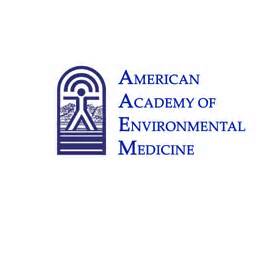

www.aaemonline.org
- © by
American Academy of Environmental Medicine
Simply stated, Environmental Medicine is concerned with the interaction
between mankind and the environment. More specifically, Environmental Medicine
involves the adverse reactions experienced by an individual on exposure to an
environmental excitant. Excitants to which individual susceptibility exists are
found in air, food, water, and drugs, and are frequently found in the home,
work, school, and play environments. Exposures to these
agents may adversely affect one or more organ system and this effect is commonly
not recognized by individuals and their physicians.
Environmental Medicine offers a sweeping reinterpretation of medical thinking,
especially in its approach to many previously unexplained and ineffectively
treated chronic diseases. The basis of this view is the
simple concept that there are causes for all illnesses, and the obvious
but not well accepted fact, that what we eat or are exposed to in our
environment, has a direct effect upon our health.
The basic theories of Environmental Medicine include the
"total
load" concept, individual
susceptibility, and
adaptation. The
"total
load" concept postulates that multiple and chronic environmental
exposures in a susceptible individual contribute to a breakdown of that person's
homeostatic mechanisms. Rarely is there only one offending agent responsible for
causing a diseased condition. Multiple factors co-exist, usually over a
prolonged period of time in bringing about the disease process. Individual
susceptibility to environmental agents occurs for a variety of reasons including
genetic predisposition, gender, nutritional status, level of exposures to
offending substances, infectious processes, and emotional and physical stress.
Adaptation
is defined as the ability of an organism to adjust to gradually chaning
sustained circumstances of its existence. Maladaptation would be a
breakdown of the adaptive mechanism.
The American Academy of Environmental Medicine was founded
in 1965, and is an international association of physicians and other
professionals interested in the clinical aspects of man and his environment. The
Academy is interested in expanding the knowledge of interactions between human
individuals and their environment, as these may be demonstrated to be reflected
in their total health.
The Academy of Firsts: The founders and members of the
American Academy of Environmental Medicine are recognized as the first to
describe or the first organization to acknowledge ...
- Serial
Dilution Endpoint Titration
- Sublingual
Immunotherapy
- Optimal
Dose Immunotherapy
- Food
Allergy/Addiction
- Provocation/Neutralization
- Avoidance/Reintroduction
Challenge Testing
- Rotary
Diversified Diet
- Chemical
Sensitivity (MCS)
- Total
Load Phenomenon
- Environmental
Control in the Home, Workplace, and Hospital
- Chemically
Less-Contaminated Foods
- Sauna
Depuration
- Hepatic
Detoxication Enhancement
- Gulf
War Syndrome
- Endocrine
Mimicry Disorders
- The
Role of Mold in the Development of Systemic Illness
- Yeast
Syndrome
- CFID/FMS
Search this site for a practitioner in your area.
www.bastyr.edu
For naturopathic medicine, which emphasizes the
interconnected nature of health, environmental medicine is a natural fit. At
Bastyr, that’s reflected in classes, clinical research, and focused clinical
care that helps patients find protection and healing from environmental
dangers.
John
Hibbs, ND, a member of Bastyr’s second graduating class in 1983, has
seen environmental medicine move from a fringe specialty to an increasingly
central part of 21st century health care. As Bastyr’s most senior faculty
member, he trains graduates to contribute to that field.
"We're on the verge of realizing as a medical culture
that detoxification therapies need to be a part of our lives," he says.
"We've created a fairly toxic world, and we need to take steps in order to
be well and prevent illness. But I believe we can teach this in a positive,
non-scary way, because it's so doable."
top
Top 10 Things
You Can Do To “Practice Prevention”

Retrieved from -
www.healthandenvironment.org
-
Buy
non-toxic products for your home.
Many products that people use
in their home surprisingly contain highly toxic materials. Fortunately, non-toxic
alternatives for most of these products exist. Buy less toxic cleaning
products. Avoid pesticides. Replace mercury thermometers with digital
ones. For other specific suggestions and alternatives, see the “Practice
Prevention” columns on www.iceh.org as
well as other resources and fact sheets on
www.watoxics.org and
www.checnet.org.
-
Keep
indoor environments healthy.
Pesticides and other toxic
chemicals can be tracked in from the outdoors onto the floors where
children play. Wipe shoes on doormats and leave
them at the door. Also
vacuum regularly with a HEPA (High Efficiency
Particulate Air) filter vacuum. Old vacuums can blow contaminated dust
from the carpet out into the air. Dust particles can be inhaled and
ingested after settling on food, hands and furniture.
-
Don’t
reheat or microwave foods in plastic containers.
Many plastics when heated leech
toxins that can cause reproductive disorders and cancer and disrupt the
hormone messaging system in the body. For further information and to
find out which plastics appear to be safer, see:
www.ecologycenter.org/ptf/toxins.html.
-
Eat
lower on the food chain.
Many toxics bioaccumulate up
the food chain and are stored in fatty tissues. Choose low-fat dairy,
remove the fat from meats, and substitute grains, beans and vegetables
whenever possible.
-
Buy
organic and local.
Whenever possible, buy organic and locally grown foods. Organic
foods are grown without highly hazardous pesticides and eating organic
lowers your exposure to pesticides. Buying locally grown foods means you
are supporting regional farmers and not using limited natural resources
to truck or ship food in. Visit
www.foodnews.org to learn more about organic, and
www.seattletilth.org for more
information about local options.
-
Dispose
of household toxic products properly.
Many items in our homes - from
paints to pesticides, batteries, and even energy-efficient compact fluorescent
light bulbs - contain toxic ingredients. Be sure to dispose of these
items properly, which generally means dropping them off at your local
household hazardous waste site. See
http://1800recycle.wa.gov for the site closest to you.
-
Become
a member of an organization or volunteer with your favorite
organization. There are dozens of effective organizations working in Washington state
to protect our health environment. A little bit of money goes a long way
for all of these groups. Visit
www.esw.org for a listing of some of these organizations. In
addition, every organization working to protect public health has a long
list of things that it needs help with, from pulling invasive weeds to
stuffing envelopes, from legal research to making phone calls. Contact
your favorite organization and see what help they need. Volunteers make
a huge difference.
-
Educate
yourself about the issues.
There is a vast amount of
information available about toxic pollution and its impacts on human health and the environment.
Take the time to read up on the issues and educate yourself. For the
latest news, see
www.environmentalhealthnews.org.
-
Become
a community organizer.
Many communities are no longer
using pesticides on public parks and recreational areas and are asking
school districts to use integrated pest
management practices. For information about how you can take steps in
your community, see
www.beyondpesticides.org,
www.watoxics.org and www.chej.org.
-
Take
action to eliminate persistent toxic chemicals including mercury, PCBs,
dioxin, and PBDEs in Washington.
The state legislature is
debating funding for a critical program to eliminate some of the most
dangerous chemicals on the planet. Contact your legislators and urge
them to support this program. See
www.watoxics.org for more information.
Download pdf
file -
Top 10 Things You Can Do To
"Practice Prevention"
top
Heavy
Metals Lab Results for Off-the-Shelf Food Products
Retrieved from
labs.naturalnews.com - News-2014-01-08
TUCSON, Ariz., Jan. 8, 2014 -- In conjunction with the
non-profit Consumer Wellness Center (ConsumerWellness.org), Natural News (NaturalNews.com)
has begun publishing heavy metals lab reports for off-the-shelf food
products. With industrial pollution worsening and many "organic" foods now
imported from China, heavy metals and toxic elements are increasingly being
found in foods purchased by consumers, including some certified organic
foods.
Through NaturalNews.com, heavy metals lab results are
available free to the public and include parts per billion (ppb)
concentrations of Aluminum, Arsenic, Cadmium, Mercury, Lead and Copper. Due
to concerns about foods absorbing radioactive fallout from the Fukushima
catastrophe, results for Cesium and Uranium are also included. Toxic
elements are linked to diseases like cancer, Alzheimer's, schizophrenia,
kidney failure, cognitive impairment, birth defects, hardening of the
arteries and more.
Testing is conducted via ICP-MS (Inductively Coupled
Plasma Mass Spectrometry), using high-level analytical chemistry and cutting
edge scientific instrumentation.
Foods being tested by the CWC include fast foods,
conventional grocery products, breakfast cereals, superfoods, protein
powders, infant formula, packaged meats, dairy products, sodas, teas and
dietary supplements. A small selection of lab results is already published,
with dozens more posted each week. Results are
available now at:
labs.naturalnews.com
top
The
Impacts of GMOs on the Environment
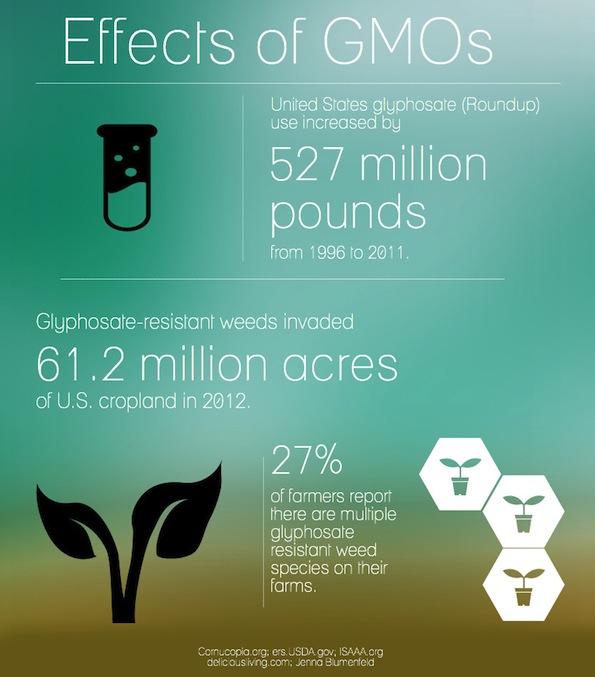
www.nongmoproject.org © NON-GMO PROJECT
Over 80% of all GMOs grown worldwide are engineered for herbicide
tolerance. As a result, use of toxic herbicides like Roundup has increased
15 times since GMOs were introduced. GMO crops are also responsible for the
emergence of “super weeds” and “super bugs:’ which can only be killed with
ever more toxic poisons like 2,4-D (a major ingredient in Agent Orange).
GMOs are a direct extension of chemical agriculture, and are developed and
sold by the world’s biggest chemical companies. The long-term impacts of
GMOs are unknown, and once released into the environment these novel
organisms cannot be recalled.
www.globalresearch.ca -
death-of-the-bees-genetically-modified-crops-and-the-decline-of-bee-colonies-in-north-america reports,
This
article was originally published by Global Research in March 2008
-
Commercial
beehives pollinate over a third of [North}America’s crops and that web of
nourishment encompasses everything from fruits like peaches, apples,
cherries, strawberries and more, to nuts like California almonds, 90 percent
of which are helped along by the honeybees. Without this pollination, you
could kiss those crops goodbye, to say nothing of the honey bees produce or
the flowers they also fertilize’.1
This essay will discuss the arguments and
seriousness pertaining to the massive deaths and the decline of Bee colonies
in North America. As well, it will shed light on a
worldwide
hunger issue that will have an economical and ecological impact in the very
near future.
There are many reasons given to the decline in
Bees, but one argument that matters most is the use of Genetically Modified
Organisms (GMO) and "Terminator Seeds"
that are presently being endorsed by governments and forcefully utilized as
our primary agricultural needs of survival. I will argue what is publicized
and covered by the media is in actuality masking the real forces at work,
namely the impact of genetically modified seeds on the reproduction of bee
colonies across North America.
Genetically modified seeds are
produced and distributed by powerful biotech conglomerates. The latter
manipulate government agricultural policy with a view to supporting their
agenda of dominance in the agricultural industry. American conglomerates
such as Monsanto, Pioneer Hybrid and others, have created
seeds that reproduce only under
certain conditions, often linked to the use of their own brands of
fertilizer and/or insecticide.
The genetic modification
of the plant leads to the concurrent genetic modification of the flower
pollen. When the flower pollen
becomes genetically modified or sterile, the bees will potentially go
malnourished and die of illness due to the lack of nutrients and the
interruption of the digestive capacity of what they feed on through the
summer and over the winter hibernation process...
I will
argue that the media reports tend to distract public opinion from the true
cause which underlies the destruction of bee colonies. As such, outlined are
four major arguments which the biotech conglomerates (which produce and
market GMO seeds) have used to mislead the public regarding the demise of
the bees. These arguments include
Varroa mites, parasites, cell phones, and terminator seeds…
The Ecological Impact of horizontal gene transfer and increase of rampant
disease is not fully examined and if so, is kept silent by these
Conglomerates. The Economic impact of
the bee colony collapse would mean inflation, scarcity of agricultural
commodities, and ultimately the collapse of North American agriculture.
The Environmental Impact of scarcity and increased demand for
resources, will beyond doubt have severe repercussions for our long-term
food security. The
bio-diversity of the bees causes positive economic and ecological
externalities. The negative externalities have yet to be fully grasped or
understood.
Organic crops still relatively
untouched: The truth is that organic farming is relatively untouched as the
bee crisis is concerned. Organic farming maintains the diversity of the
eco-system and preserves the quality of the foods produced. The economic
impact that the scarcity of bees will potentially have on our society as a
whole is very worrisome. In the end, only our children will fully realize;
that it was greed that destroyed our beautiful blue planet.
www.thelibertybeacon.com - 2013/02/18
epa-approved-gmo-insecticide-responsible-for-killing-off-bees-puts-entire-food-chain-at-risk
- reports,
New information has come out that links
an insecticide approved by the EPA (Environmental Protection Agency) to
killing off millions of Bees and puts food chain at risk.
In early 2011 several leaked documents obtained by a Colorado beekeeper
brought light to the fact that the U.S.
Environmental Protection Agency‘s (EPA) illegitimate approval of
Clothianidin, an extremely toxic pesticide made by Bayer CropScience, came
regardless of the fact the agency knew it was capable of killing off Bees.
As a new study emerges from Purdue University, not only is it 100% confirmed
that Clothianidin is killing bees, but also that Clothinaidin’s toxicity is
now found throughout the entire food chain.
More from Natural News: The study, which was published in the online journalPLoS
ONE, investigated the various methods and routes by which a
class of insecticides known as neonicotinoids, which includes clothianidin,
are harming honey bees. They discovered that both clothianidin and
thiamethoxam, another component of neonicotinoid insecticides, persist in
“extremely high levels” in planter exhaust material produced during the
planting of crops treated with these insecticides, which runs contrary to
industry claims that the chemicals biodegrade and are not a threat.
The research team also found neonicotinoid compounds in soil, including in
fields where the chemicals were not even sprayed, as well as on various
plants and flowers visited by bees. Based on their analysis, the researchers
involved with the study determined that bees actively transfer contaminated
pollen from primarily neonicotinoid-treated corn crops, and bring it back to
their hives. The bees also transfer neonicotinoid compounds to other plants
and crops not treated with the chemicals, which shows just how persistent
these chemicals truly are in the environment.
Read the entire report at www.ncbi.nlm.nih.gov
www.washingtonpost.com - 2013/05/03 -
why-are-bees-dying-the-u-s-and-europe-have-different-theories
reports,
The mysterious collapse of bee colonies around the world has turned into a
real crisis. In the United States, domesticated bee populations have reached
a 50-year low and keep dwindling. The situation is just as dire in many
other countries.
And that’s bad news for all those crops that depend on bees. The U.N. Food
and Agriculture Organization estimates that
“out of some 100 crop species which provide 90% of food worldwide, 71 of
these are bee-pollinated.” Around the world, these crops are worth at least
$207 billion.
So why are bee
colonies collapsing? And what’s the best way to halt the decline? As it
turns out, regulators in the United States and Europe are taking very
different approaches to these questions. The European Union, for its part, is now moving to ban a
certain class of pesticides, neonicotinoids, as a precautionary measure...
The
European Commission will enact a two-year ban on a class of pesticides
thought to be harming global bee populations, the European Union’s health
commissioner said Monday...
In the United States, by contrast, regulators
are moving more slowly. A big new report (pdf)
out Thursday from the Agriculture Department and the Environmental
Protection Agency argued there were a wide variety of reasons for the
disappearance of U.S. honeybees since 2006...As such, U.S. regulators aren’t ready to ban pesticides
the way Europe just did. The EPA is slowly conducting a review on the topic
that “should be completed in
five years.”
The link between pesticides and bee die-offs is still subject to
some dispute. So, in the face of uncertainty, the European Commission is
erring on the side of the environment — voting to ban neonicotinoids for two
years just in case they really are to
blame for the bee collapse...The United States, meanwhile, is
erring on the side of certain economic interests — it’s still not clear that
neonicotinoids are to blame, and pesticides are a billion-dollar industry,
so regulators are moving slowly in setting restrictions.
www.nationofchange.org -
russia-bans-use-and-import-monsanto-s-gmo-corn-following-study
Following the groundbreaking French
study that graphically linked the
lifetime consumption of Monsanto’s GMO corn in rats to massive tumors and
direct organ failure, Russia’s premiere consumers rights organization has
suspended both the importation
and use of Monsanto’s GMO corn within the nation’s borders.
It seems that France has become somewhat of a consumer health watchdog in
more than just one area, simultaneously tackling the issue of pesticide
contamination as well. It was even
announced that the French government was seeking to ban crop dusters in all
areas possible, aiming to reduce the amount of obesity-linked
pesticides within the food supply.
Meanwhile, Monsanto is continuing to stick to its tired statements regarding
the ‘safety’ of its GMO crops and Roundup herbicide. Instead of discussing
not only the French study finding that the company’s GMOs led to horrendous
tumors that led to rats literally dragging them along the ground as they
walked, they claim that the information ‘does not warrant’ any concern at
all from European officials. Just as Monsanto (and the US government)
ignored evidence linking Roundup to DNA
damage and infertility,
it appears they intend to do it once more and hope that it all goes away.
Unfortunately for Monsanto, it’s not going away this time.
With Russia now acting to secure food safety, many other nations will surely
follow. While the United States may continue to ignore the issues
surrounding GMOs and Monsanto’s blatant disregard for human health (they
were caught running ‘slave-like’ working rings, after all), many foreign
nations will not. Countries like Poland, Peru,
and Hungary have already taken action in banning or removing Monsanto’s GMO
crops.
top
What Are the Hazards of Heavy
Metals 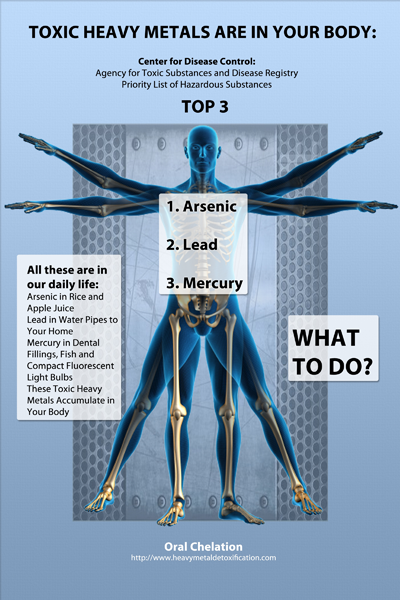
Source -
www.psr.org - Physicians for Social Responsibility
The term heavy metal refers to any metallic chemical element that has a
relatively high density and is toxic or poisonous at low concentrations.
Examples of heavy metals that are harmful to humans include
mercury, lead,
and arsenic.
Chronic exposure to these metals can have serious health consequences.
Humans are exposed to heavy metals through inhalation of air pollutants,
consumption of contaminated drinking water, exposure to contaminated soils
or industrial waste, or consumption of contaminated food. Food sources such
as vegetables, grains, fruits, fish and shellfish can become contaminated by
accumulating metals from surrounding soil and water. Heavy metal exposure
causes serious health effects, including reduced growth and development,
cancer, organ damage, nervous system damage, and in extreme cases, death.
Exposure to some metals, such as mercury and lead, may also cause
development of autoimmunity, in which a person's immune system attacks its
own cells. This can lead to joint diseases such as rheumatoid arthritis, and
diseases of the kidneys, circulatory system, and nervous system.
Metals are particularly toxic to the sensitive, rapidly developing systems
of fetuses, infants, and young children. Some metals, such as lead and
mercury, easily cross the placenta and damage the fetal brain. Childhood
exposure to some metals can result in learning difficulties, memory
impairment, damage to the nervous system, and behavioral problems such as
aggressiveness and hyperactivity. At higher doses, heavy metals can cause
irreversible brain damage. Children may receive higher doses of metals from
food than adults, since they consume more food for their body weight than
adults.
Retrieved from -
www.healthy.net
There are possibly more problems
from these metals, which interfere with normal bodily function, than have been
considered in most medical circles. Lead, mercury, cadmium, arsenic, and,
more recently, aluminum are the main
toxic minerals. Beryllium, bismuth, and bromine must be considered as
well. And there are other heavy and radioactive metals that could bring future
difficulties. At present, these toxic metals have polluted our atmosphere, our
waters, our soil, and food chain.
Blood or urine analysis is not
very reliable for measuring toxic levels of most of these heavy metals,
especially with long-term exposure and tissue buildup.
Hair analysis, though controversial, offers
the best available evaluation for accumulation of heavy metals, and in many
studies, hair levels do correlate fairly well with tissue stores. The heavier the element, the more reliable is the hair analysis.
Measuring these toxic minerals is probably the most useful aspect of hair
analysis.
Absorption of these metals is usually pretty low as well. But when our natural
means of elimination are reduced or our exposure is increased, we may run into
trouble.
The basic way that these heavy metals cause
problems is by displacing or replacing related minerals that are required for
essential body functions. For example, cadmium
can replace zinc, and lead displaces calcium; when this happens, the cadmium or
lead is stored in the bones or other tissues and becomes harder to clear, while
the important functions of the minerals that are replaced cannot be carried out.
Reliable online source that outlines in-depth information on heavy metals,
sources of contamination and detoxification therapies.
top
How Can I Reduce My Exposure of Heavy
Metals?
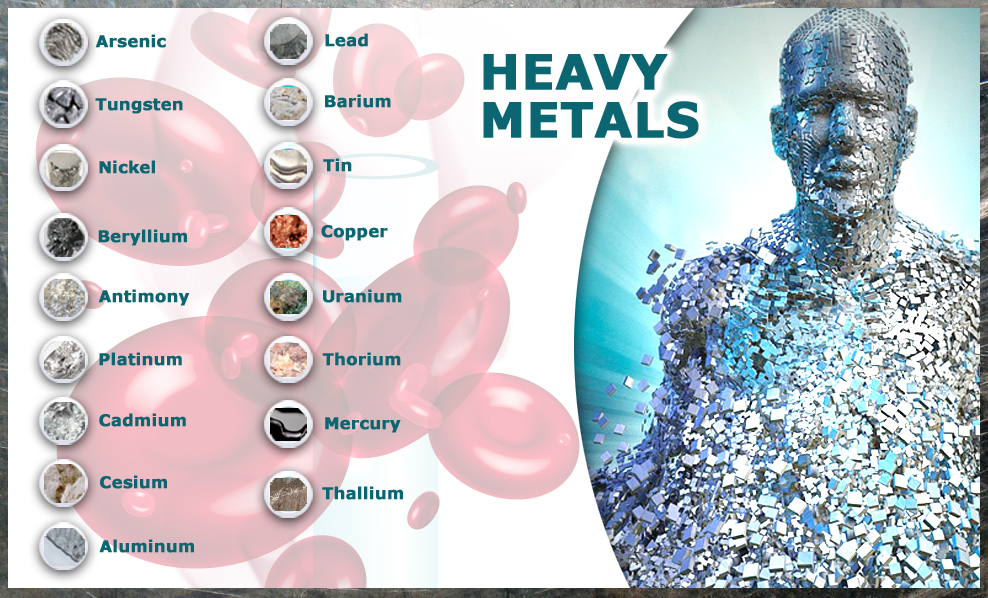
Source -
www.saferchemicals.org
© 2014 Safer
Chemicals, Healthy Families
We come into contact with
lead, mercury, and arsenic in many ways, but there are some steps we can
take to reduce our exposure.
Remove treated wood. Remove
wood treated with the preservatives CCA or ACZA, which contain arsenic. If
removing arsenic-treated wood is not an option, you can paint or seal the
wood to reduce leaching and contact exposure. Choose semi-transparent deck
stains for deck surfaces and play structures, and latex paint for fences,
tables, and other furniture. Reapply the coating when it shows signs of
deterioration.
Choose fish wisely. Avoid
fish high in mercury, such as king mackerel, tilefish, swordfish, orange
roughy, and marlin. Limit consumption of tuna, especially steaks and canned
‘white’ albacore. Lower-mercury choices include wild salmon, sardines,
anchovies, Atlantic herring, Dungeness crab, Pacific cod, Alaskan black cod,
farmed striped bass, farmed catfish, clams, mussels, and Pacific oysters.
If you eat
sport-caught fish, check for specific guidance on mercury levels in
Washington water bodies or coastal waters. Fish and shellfish advisories are
available from the Washington State Department of Health
Limiting
mercury intake from fish is especially important for young children and
women who are pregnant, nursing, or of child-bearing age.
You can find additional
guidance on fish choices at the following website
www.montereybayaquarium.org.
Fish are an
excellent source of nutrients, including protein, omega-3 fatty acids, and
vitamin D, and we encourage people to continue eating fish following these
precautions.
Watch for lead paint. If
you live in a home built before 1978, it is likely to contain lead-based
paint. If the paint is chipping, peeling, or otherwise deteriorating, or if
you want to remodel, hire a certified abatement worker to remove or contain
contaminated paint. Use door mats, remove shoes at the door, and
vacuum and clean regularly to reduce lead that accumulates in house dust.
Protect drinking water. Avoid
exposure to lead that may be leaching from plumbing by flushing your cold
water pipes (run water until it becomes as cold as it will get) before
drinking, and only use cold water for drinking or cooking.
Avoid PVC. Choose
alternatives to products made of PVC, which often contain lead, especially
for items that are likely to come into direct contact with children’s hands
and mouths, such as toys, teethers, and lunchboxes. Old toys and furniture
made prior to 1978 may also contain lead-based paint. For consumer product
safety information and recalls for lead products, visit the Consumer
Product Safety Commission’s website.
Watch for lead in dishware. Do
not use old, imported, or homemade ceramic dishware, unless you know that
the glazes do not contain lead. Avoid leaded crystal, as well as imported
food cans, which can contain lead solder.
Make sure medicines are free of toxic metals. Some home remedies, as
well as drugs and cosmetics, can contain these metals. Look at ingredient
lists, talk to your doctor, and avoid folk remedies and other medicines that
contain lead, arsenic, or mercury.
Be cautious with mercury-containing products.
When possible, choose products without mercury, such as digital thermostats
and thermometers. Be careful not to break fluorescent light bulbs, mercury
thermometers, or other household items containing liquid mercury. These
products release harmful mercury vapors when broken. If they do break, use
appropriate clean-up methods (see the EPA's
web site).
Check paints and art supplies. Avoid
paints containing mercury compounds, which are still found in some paints as
pigments. Also avoid lead solder and artists’ paints and glazes that contain
lead. Information on some products containing these ingredients is available
from the Household Products Database. Otherwise, ask the manufacturer.
Skip herbicides with arsenic. Avoid
arsenic-containing herbicides, which have ingredients listed as monosodium
methanearsonate (MSMA), calcium acid methanearsonate, or cacodylic acid.
Consider composite fillings. Consider
choosing composite dental fillings rather than mercury-containing amalgam
fillings.
top
Vaccine/Immunization
Safety Issues 
www.thinktwice.com
- Thinktwice
Global Vaccine Institute
Copyright ©
Toxic Mercury in
Vaccines
- Some vaccines
contain toxic mercury in the form of thimerosal. Children are susceptible to
adverse reactions due to the number of mandated immunizations containing this
substance.
Published on Thursday, June
16, 2005 by Salon.com
Deadly Immunity
- When a study revealed that
mercury in childhood vaccines may have caused autism in thousands of kids,
the government rushed to conceal the data -- and to prevent parents from
suing drug companies for their role in the epidemic. By Robert F. Kennedy
Jr.
According to a CDC epidemiologist named Tom
Verstraeten, who had analyzed the agency's massive database containing the
medical records of 100,000 children, a mercury-based preservative in the
vaccines -- thimerosal -- appeared to be responsible for a dramatic increase
in autism and a host of other neurological disorders among children… But
instead of taking immediate steps to alert the public and rid the vaccine
supply of thimerosal, the officials and executives at Simpsonwood spent most
of the next two days discussing how to cover up the damaging data. According
to transcripts obtained under the Freedom of Information Act, many at the
meeting were concerned about how the damaging revelations about thimerosal
would affect the vaccine industry's bottom line…
What is most striking is the lengths to which many of
the leading detectives have gone to ignore -- and cover up -- the evidence
against thimerosal. From the very beginning, the scientific case against the
mercury additive has been overwhelming. The preservative, which is used to
stem fungi and bacterial growth in vaccines, contains ethylmercury, a potent
neurotoxin. Truckloads of studies have shown that mercury tends to
accumulate in the brains of primates and other animals after they are
injected with vaccines -- and that the developing brains of infants are
particularly susceptible. To read in entirety…
http://www.thinktwice.com/Kennedy.pdf
www.thinktwice.com
- The Vaccine Safety Manual
contains the most extensive information available on both the
historical and current use of
mercury (thimerosal) in vaccines (including studies
linking it to autism and other neurological and immunological disorders).
The Vaccine Safety Manual is the world's most complete
guide to immunization risks and protection. It includes pertinent
information on every major vaccine: polio, tetanus, MMR, hepatitis A, B, HPV
(cervical cancer), Hib, Flu, chickenpox, shingles, rotavirus, pneumococcal,
meningococcal, RSV, DTaP, anthrax, smallpox, TB, and more. All of the
information, including detailed vaccine safety and efficacy data, is written
in an easy-to-understand format, yet includes more than 1,000 scientific
citations. More than 100 charts, graphs and illustrations supplement the
text. This encyclopedic health manual is an important addition to every
family's home library and will be referred to again and again.
top
Mercury In Thermometers
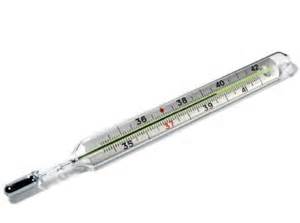
Retrieved from -
watoxics.org -
Washington Toxics Coalition
One
gram of mercury, like that in a thermometer, is enough to contaminate the
fish in a 20-acre lake to the point where they are unsafe for human
consumption (Minnesota Pollution Control Agency 1999).
If it is not cleaned up, the mercury will evaporate at room temperature,
potentially reaching dangerous levels in indoor air. The risks increase if
you clean up the mercury spill with a vacuum cleaner, if the mercury is
heated, or if the spill takes place in a small, poorly ventilated room.
How to Clean Up if a
Mercury Thermometer Breaks
Every year there are 15,000 calls to poison control centers about broken
mercury thermometers (Health Care Without Harm, 2001). If your mercury
thermometer breaks, it is very important for the mercury to be cleaned up
properly. Follow these steps:
Reference -
www.epa.gov
NOTE: these instructions also
apply to spills from other sources, if the amount spilled is less than or
similar to the amount in a thermometer (see specific
information about how to clean up broken fluorescent bulbs)
-
Have everyone else leave the area; don't let anyone walk through the
mercury on their way out. Make sure all pets are removed from the area.
Open all windows and doors to the outside; shut all doors to other parts
of the house.
-
DO NOT allow children to help you clean up the spill.
-
Mercury can be cleaned up easily from the following surfaces: wood,
linoleum, tile and any similarly smooth surfaces.
-
If a spill occurs on carpet, curtains, upholstery or other absorbent
surfaces, these contaminated items should be thrown away in accordance
with the disposal means outlined below. Only cut and remove the affected
portion of the contaminated carpet for disposal.
Cleanup Instructions
-
Put
on rubber, nitrile or latex gloves.
-
If
there are any broken pieces of glass or sharp objects, pick them up with
care. Place all broken objects on a paper towel. Fold the paper towel
and place in a zip lock bag. Secure the bag and label it as directed by
your local health or fire department.
-
Locate
visible mercury beads. Use a squeegee or cardboard to gather mercury
beads. Use slow sweeping motions to keep mercury from becoming
uncontrollable. Take a flashlight, hold it at a low angle close to the
floor in a darkened room and look for additional glistening beads of
mercury that may be sticking to the surface or in small cracked areas of
the surface. Note: Mercury can move surprising distances on hard-flat
surfaces, so be sure to inspect the entire room when "searching."
-
Use the
eyedropper to collect or draw up the mercury beads. Slowly and carefully
squeeze mercury onto a damp paper towel. Place the paper towel in a zip
lock bag and secure. Make sure to label the bag as directed by your
local health or fire department.
-
After you
remove larger beads, put shaving cream on top of small paint brush and
gently "dot" the affected area to pick up smaller hard-to-see beads.
Alternatively, use sticky tape, such as duct tape, to pick up any
remaining small glass fragments. Place the paint brush or duct tape in a
zip lock bag and secure. Make sure to label the bag as directed by your
local health or fire department.
-
OPTIONAL
STEP: It is OPTIONAL to use commercially available powdered sulfur to
absorb the beads that are too small to see. The sulfur does two things:
(1) it makes the mercury easier to see since there may be a color change
from yellow to brown and (2) it binds the mercury so that it can be
easily removed and suppresses the vapor of any missing mercury. Where to
get commercialized sulfur? It may be supplied as mercury vapor absorbent
in mercury spill kits, which can be purchased from laboratory, chemical
supply and hazardous materials response supply manufacturers. Note: Powdered
sulfur may stain fabrics a dark color. When using powdered sulfur, do
not breathe in the powder as it can be moderately toxic. Additionally,
users should read and understand product information before use.
-
If you
choose not to use this option, you may want to request the services of a
contractor who has monitoring equipment to screen for mercury vapors.
Consult your local environmental or health agency to inquire about
contractors in your area. Place all materials used with the cleanup,
including gloves, in a trash bag. Place all mercury beads and objects
into the trash bag. Secure trash bag and label it as directed by your
local health or fire department.
-
Contact your local health department,
municipal waste authority or your local fire department for proper
disposal in accordance with local, state and federal laws.
Remember to keep the area well ventilated to the outside (i.e., windows
open and fans in exterior windows running) for at least 24 hours after
your successful cleanup. Continue to keep pets and children out of
cleanup area. If sickness occurs, seek medical attention immediately. View
information on health effects related to exposures to vapors from
metallic mercury.
For additional information on health effects, the Agency for Toxic
Substances and Disease Registry (ATSDR) provides a Mercury
Fact Sheet
If you have further questions, or if there
are young children or pregnant women in the house at the time of the
thermometer breakage, please call your local poison control center at
1-800-222-1222.
A
variety of mercury-free alternatives are available at your local pharmacy.
top
www.fda.gov
Inorganic mercury compounds take the form of mercury salts. They are
generally white powders or crystals, with the exception of mercuric sulfide
(cinnabar) which is red. Inorganic compounds and organic compounds (such as
phenylmercury acetate and ethylmercury), have been commonly used as
fungicides, antiseptics or disinfectants. They have also been used in a
variety of products. Most of these uses have been discontinued,
but small amounts of these compounds can still be found as preservatives in
some medicines.
The U.S. Food and Drug Administration maintains a list
of medicines that contain mercury.
…The mercury ingredients are abbreviated as TM for thimerosal, PMA for
phenylmercuric acetate, PMN for phenylmercuric nitrate, MA for mercuric
acetate, MN for mercuric nitrate, MB for merbromin, and MOY for mercuric
oxide yellow. The list includes nonhomeopathic human and veterinary drug
products and human biological products. Homeopathic drug products are not
included because of the low amounts of mercury present in the products. The
abbreviation NS under the % column means that the information was "not
stated" in the agency's Drug Registration and Listing System.
Examples you will find….
|
Manufacturer
|
Name of Product
|
Ingredient
|
%
|
|
CVS
|
Nasal Spray Pump
|
PMA
|
NS
|
|
CVS Revco DS Inc.
|
12 Hour Decongestant Pump Nasal Spray.
|
PMA
|
NS
|
|
Click Here to View Complete Listing
Thimerosal content for biological
products can be found at Thimerosal
in Vaccines and Mercury
in Plasma-Derived Products.
www.mercurypolicy.org
© Mercury Policy Project
U.S.
House Oversight Hearing Focuses on FDA Regulatory Tools and the Environmental
Impacts of Mercury Tooth Fillings: Dental mercury releases from
clinics are the largest contributor of mercury to municipal wastewater treatment
plants in the U.S. and are a significant contributor of mercury emissions to the
environment and the fish Americans eat. Between 25 and 34 tons of mercury
are used in mercury-based dental fillings each year to fill tooth cavities, and
half of all mercury still used in commerce is in Americans’ mouths -- about
1,000 tons.
The
role of mercury tooth fillings, often called amalgams, in dentistry has become
an issue of increasing concern for lawmakers recently for both environmental and
health reasons. According to a recent article in FDA Week,
“Subcommittee members Diane Watson (D-CA) and Dan Burton (R-IN) have pushed
for hearings on dental amalgams… The lawmakers reintroduced legislation May 1
that would phase out such amalgams.”
To read more www.mercurypolicy.org
top
Mercury In
Amalgam Tooth Filings
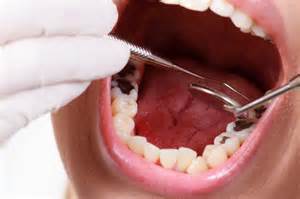
www.toxicteeth.org
© Copyright Consumers for Dental Choice, Inc.
Dental amalgam is a
primitive filling material made of between 43 and 54 percent mercury.
Amalgam fillings are commonly called as “silver fillings” – a marketing term
that deceives many consumers into believing that amalgam is
mainly silver, which is only a minor
component of amalgam. Amalgam is not stable after it is implanted into human
teeth – it constantly releases mercury vapor into your body. And this
mercury bioaccumulates.
Retrieved from -
iaomt.guiadmin.com
- International Academy of Oral Medicine
Toxicology
The-Case-Against-Amalgam.pdf:
Dental
amalgam has been controversial ever since it was introduced, early in the
nineteenth century, because of its mercury content. People of the Napoleonic era
knew full well that mercury was poisonous, and the best that anyone has ever
claimed about amalgam is that the mercury exposure may be too small to hurt
anyone. Over time, though, a great body of evidence has accumulated
showing that mercury is release from amalgam in significant quantities, that it
spreads around the body, including from mother to fetus, and that the
exposure causes physiological harm. A growing number of dentists, physicians, researchers,
citizen activists, politicians, and regulators have come to the conclusion that
the time has come to consign amalgam to the “dustbin of history.” This
article will sketch out the main points of the scientific case against amalgam.
We have accumulated a formidable body of evidence
establishing the chain of toxic events:
-
Amalgam releases significant amounts of mercury;
-
The mercury distributes to tissues around the body,
and is the biggest source of mercury body burden;
-
The mercury from amalgam crosses the placenta and
into breast milk, resulting in significant pre- and post-partum exposures
for infants; and
-
Adverse physiological changes occur from that exposure
on the immune, renal, reproductive and central nervous systems, as well
as the oral and intestinal flora.
-
Mercury exposure is known to induce autoimmune
reactions in susceptible animals,61
62 63 and one investigation shows the same for amalgam.
About 27% of US dentists are reported in 2001 to be
practicing mercury free.1
To
read this article in its entirety…www.iaomt.org
-The Case Against Amalgam.pdf
This dramatic video
of mercury vapor out gassing from an amalgam dental filling has outraged the
world since it was first demonstrated at an IAOMT meeting in 1995. To view
video...
International Academy of
Oral Medicine & Toxicology
top
Why Public Awareness
of Amalgam Counts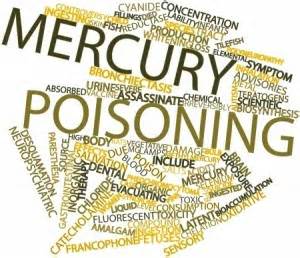
Retrieved from -
mercola.com
Mercury is a neurotoxin, the most toxic and the most volatile of the heavy
metals. Dental
amalgam is composed of about 50 percent mercury, a well-known neurotoxin.
Evidence shows mercury is easily released in the form of vapor each time you
eat, drink, brush your teeth or otherwise stimulate your teeth…
Oral Health and Overall Health Are Linked
-
Holistic dentists, also called biological dentists, view your teeth and gums
as an integrated part of your entire body, meaning that oral health problems
can be linked to overall health problems and vice versa. For example, they
know that putting a toxin, like the mercury in amalgam fillings, into your
teeth can be harmful to your overall health.
Like holistic dentists, Consumers for Dental Choice knows that the problems
with amalgam fillings go far beyond the tooth, affecting your overall health
and well-being in many ways... some more well-known than others. If you are
a regular reader, you know amalgam releases mercury – a neurotoxin and
reproductive toxin – into your body. But did you know about these other
problems caused by the amalgam in your teeth?
-
Environment:
Amalgam pollutes 1) water via dental clinic releases and human waste; 2)
air via cremation, dental clinic emissions, sludge incineration, and
respiration; and 3) land via landfills, burials, and fertilizer. Once in
the environment, dental mercury converts to its even more toxic form:
methylmercury and becomes a major source of mercury in the fish people
eat. Dental mercury in the environment can cause brain damage and
neurological problems, especially for children and the unborn babies,
according to the United States Environmental Protection Agency.
-
Workplace:
Due to mercury exposure from amalgam in the workplace, studies have
shown that dental workers have elevated systemic mercury levels. Few of
these dental workers – mostly women of child-bearing age - are given
protective garb or air masks to minimize their exposure to mercury; many
are not aware of the risks of occupational mercury exposure. As a
result, dental workers have reported neurological problems, reproductive
failures, and birth defects caused by amalgam in the workplace.
And the amalgam problem even goes beyond mercury…
-
Broken
teeth:
Placing amalgam requires the removal of a significant amount of healthy
tooth matter. This removal, in turn, weakens overall tooth structure
which increases the need for future dental work. On top of that, amalgam
fillings - which expand and contract over time - crack teeth and once
again create the need for still more dental work.
-
Consent:
Most dentists do not inform consumers that amalgam contains mercury. As
a result,
over
76% of consumers do not know that amalgam
is
mainly mercury according to Zogby polls.
But once they are informed, 77% of people do not want mercury fillings -
and they were even willing to pay more to avoid this unnecessary source
of mercury exposure.
Retrieved from
www.doctoroz.com
Mercury use in health, consumer, and industrial
products has declined precipitously in all products over the past 30 years,
but in dentistry, this decline has only been slight,
such that dental fillings jumped from 2% of all mercury products two decades
ago to over 20% in 2001. In 1991, the World
Health Organization (WHO) confirmed that mercury contained in dental amalgam
is the greatest source of mercury vapor in non-industrialized settings,
exposing the concerned population to mercury levels significantly exceeding
those set for food and for air. WHO also went on to state that mercury
contained in dental amalgam and in laboratory and medical devices accounts
for about 53% of total mercury emissions – and about one-third of the
mercury in the sewage system comes from dental amalgam flushed down the
drain.
The Association of
Metropolitan Sewerage Agencies (AMSA) studied seven major waste-water
treatment plants and found that dental uses were "by far" the greatest
contributors of mercury load, on average contributing 40%, over 3 times the
next greatest contributor. The Environmental Protection Agency (EPA) also
declared that dental amalgam is a major source of mercury contamination in
waste-water.
The health debate surrounding mercury-containing
fillings is equally concerning and confusing. Peer-reviewed scientific
studies have come to opposite conclusions on whether the mercury exposure
from amalgam fillings causes health problems.
While it would be appropriate that any medical device should be proven 100%
safe BEFORE being placed in the human body, and all potential health
concerns from a known toxic environmental hazard be fully investigated,
dental amalgam continues to be used until
enough ongoing research is accepted proving it is unsafe and unsuitable...
A 2003 monograph on mercury toxicity from the World
Health Organization (WHO) concluded that studies on humans and animals
demonstrated that dental amalgam contributes significantly to mercury body
burden in humans with amalgam fillings, and dental amalgam is the most
common form of exposure to elemental mercury in the general population.
www.icnr.com - International Center for Nutritional Research Copyright ©
1996-2013
While the dental amalgam filling, which is half
mercury, has been banned in Norway and Sweden, in the USA, the American
Dental Association and the FDA continue to defend the use of the amalgam
mercury filling, despite the clinical evidence of harm caused by amalgams
and the heavy weight of scientific studies that show that amalgams expose
patients to unacceptably large amounts of mercury and tend to harm health.
top
Symptoms of Amalgam /
Mercury Toxicity
Dental amalgam fillings
act as a time-release poison – the poison being mercury. The other
metals in amalgam, namely copper, tin, silver and zinc also have some
toxicity in their elemental forms, adding to the hazard of amalgam. Early
symptoms of amalgam / mercury toxicity include fatigue, low thyroid function
(sluggishness, weight gain, loss of sex drive, rough skin, weakened
immunity, and more), and depression (including anxiety, panic attacks,
shyness, irritability, unprovoked anger). Mercury and mercury amalgams tend
to promote fungal yeast infections, which can show up as indigestions and
bloating, ear and sinus infections, vaginal yeast infections, toenail
fungus, psoriasis, brain fog, short-term memory problems.
www.ncbi.nlm.nih.gov
The
findings presented here suggest that mercury poisoning from dental amalgam
may play a role in the etiology of mental illness.
Comparisons between subjects with and without amalgam showed significant
differences in subjective reports of mental health. Subjects who had
amalgams removed reported that symptoms of mental illness lessened or
disappeared after removal. The data suggest that inorganic mercury poisoning
from dental amalgam does affect the mind and emotions.
top
How to Test for Mercury
Toxicity
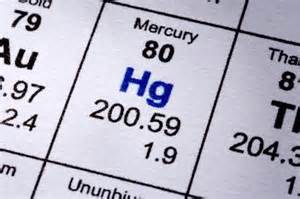
Retrieved from -
mercola.com
What You Need to
Know about Mercury Testing: Traditional mercury testing involves testing
either your hair, blood, urine, or stool. Challenge tests that implement a
chelating chemical, such as DMPS or DMSA, are also commonly used. However,
all of these tests have drawbacks. They primarily measure total mercury load
— and inaccurately at that. But most importantly they don’t give you any
information about the forms of mercury in your system or how efficiently you
are getting rid of them.
Traditional mercury tests don’t answer questions like,
how much of your mercury load is from the seafood you eat? How much from
amalgams? How well are your kidneys and liver eliminating it?
The two principal forms of mercury accumulate
differently in your body, and are eliminated by different pathways. For
example, mercury levels in your hair only reflect the mercury from the fish
you eat. But mercury levels in your urine reflect the mercury coming from
your dental fillings (plus some of the fish-based methylmercury that has
broken down into inorganic mercury). The only way to determine if there is a
problem is to compare your hair and urine levels with levels in your blood.
So, if mercury testing is to be meaningful, it must measure both of the
following:
-
Exposure level: Overall
mercury level for each of the two main forms of mercury (methylmercury,
related to your fish/seafood consumption, and inorganic
mercury, related to dental amalgam
exposure)
-
Excretion ability: How
well your body is getting rid of each kind of mercury, regardless of
your overall mercury level
A newer testing method called “mercury
speciation” does just this — it measures both of these factors. This test
uses blood, urine and hair to give you a more comprehensive picture of how
your body is eliminating mercury and where the process may be blocked. This
information can be immensely helpful in preparing a successful
detoxification plan. For more information about mercury
speciation testing, refer to my recent interview with Dr. Shade.
Overall
CAUTION - It is important to realize
that mercury detoxification is a marathon and NOT a sprint. You do NOT want
to do this quickly. Even if you believe you are healthy you want to start
this process SLOWLY as you could easily cause severe flare ups. I am one of
the healthiest people I know and when I did my program I did it over six
months. Some people may need to do it far more slowly and may need a few
years to effectively eliminate the mercury safely.
top
Considerations
for Dental Amalgam Removal
Retrieved from -
www.doctoroz.com
A 2006 poll of 2,590 US adults found that 72% of
respondents were not aware that mercury was a main component of dental
amalgam, and 92% of respondents would prefer to be told about mercury in
dental amalgam before receiving it as a filling. This could be compared to
being given a drug today by a pharmacy without the mandated FDA prescribing
information (contents, possible side effects, etc.). Unfortunately, many
dentists continue to place mercury-containing fillings, with many patients
remaining uninformed of its mercury content.
Complicating the matter
of mercury-containing fillings is the important fact that the greatest
exposure of mercury vapor to the patient (and dentist) is when dental
amalgams are first placed in the tooth and when they are removed.
Here are
five top considerations for those who should speak
to their dentist about having their amalgam fillings removed, and five top
considerations for the best protective measures and nutritional support
before and after amalgam removal and replacement.
As I mentioned,
the
greatest exposure of mercury vapor to the patient (and dentist) is
when
dental amalgams are first placed in the tooth and when they are removed. If
you are concerned about your silver fillings, have your dental team examine
your fillings to determine whether or not they are intact, and have a
conversation with your dentist about the potential health risks of keeping
or removing amalgams.
-
Patients who have recurrent decay and/or defective
margins around their dental amalgam fillings.
-
Patients who have 8 or more dental amalgam
fillings.
-
Patients who have exhibited an allergy or
sensitivity to dental amalgam (lymphocyte proliferation test).
-
Patients who have bruxism (grind their teeth).*
-
Patients who consume high quantities of acidic
foods and carbonated beverages.*
-
*demonstrated to cause prolonged higher levels of
exposure to mercury vapor from dental amalgam restorations.
top
Protective Measures and Nutritional Support for Dental Amalgam Removal
Retrieved from -
www.doctoroz.com
-
Your dentist should always use a proper isolation
technique with a dental rubber dam to minimize exposure to mercury
contact and/or swallowing amalgam debris.
-
Check that the dentist is using a high-speed and
low-speed suction device to rapidly remove amalgam, and ask for an
oxygen nose mask if available to reduce the risk of inhaling mercury
vapor during removal.
-
Take chlorella (fresh water algae tablets or
powder), a chlorophyll-rich nutritional supplement shown to assist with
mercury (and heavy metals) excretion from the intestines, before and
after amalgam replacement.
-
Vitamin C has also been shown to be effective in
assisting with mercury elimination. Take after meals and apart from
chlorella.
-
Cilantro is the most celebrated herb to assist with
intracellular mercury elimination.
top
Protocol for Detoxifying Your Body from Mercury Exposure
Retrieved from -
mercola.com
Your
Most Important Goal: Removing the Source of Exposure
Now that you understand what’s required to eliminate
mercury, we can start discussing how to support and augment your body’s
natural detoxification apparatus. That is really what “mercury
detoxification” is all about — simply helping your own natural detox system
to function better. In other words, you must “upregulate” this system.
The very first goal is to plug the hole in your leaking
ship. You must remove your source of mercury exposure, whether it’s
primarily from the seafood you eat or from amalgams (or both). Mercury
speciation testing, as described above, can help you identify which source
is problematic. There is little point in embarking on a major detox mission
if you continue exposing yourself to the offender...
that’s like trying to bail water out of a sinking boat. Avoid the
consumption of contaminated fish and seafood.
Most fish and
seafood are now contaminated, unfortunately, but some types are worse than
others. Avoiding fish is relatively easy, but having your amalgams removed
is more involved and costly and must be done with great care. You should do
this ONLY with the help of a qualified biological dentist as you can become
quite ill if your amalgams are extracted incorrectly…
Before You Do Anything Else,
Optimize Your Diet

...As with nearly every other health challenge, your diet is
a critical factor in supporting your body’s detoxification system. In fact,
consider dietary optimization the “pretoxification” phase, which should last
for two to six weeks before starting the full detoxification phase.
Your goal is to remove inflammatory and allergenic
foods such as sugar (especially fructose/HFCS),
processed and packaged foods, fast foods, most starch and grain. Your diet
should be low in carbohydrates, moderate-to-low in protein, and high in
beneficial fats (as high as 50-70 percent). Proteins repair mangled protein
molecules and supply sulfur, and fats repair your cell membranes. This type
of diet not only prepares your body for detoxification but also has the
additional benefit of improving your insulin sensitivity and reversing type
2 diabetes.
I. Boosting Your Glutathione
Production
The first requirement for effective mercury
detoxification is boosting your glutathione levels. Most forms of oral
glutathione are not effective because they are destroyed in the digestive
process. But you can consume foods that contain the precursors of
glutathione so that your body can make more of it — specifically,
cysteine-rich foods. The absolute best source is high quality whey protein.
This whey must come from the “clean” milk of organically raised cows, and
not have been overly processed, which denatures the fragile proteins.
Just be careful not to consume too much of the whey.
For more information on whey, please refer to my interview with Ori
Hofmekler, an expert on the health benefits of whey protein. The video below
is older than this article but my new position is to be careful with your
protein intake and limit the amount you are using.
Additionally, you may want to try liposomal
glutathione. Liposomal glutathione is a relatively new form of oral
glutathione that is actually well absorbed and eliminates nearly all the
concerns previously mentioned with oral glutathione. It’s encapsulated into
extremely tiny phospholipid particles, which increase its bioavailability
100-fold.
II. Mobilizing Mercury by
Boosting Enzymes and Transport Proteins
Now that your glutathione levels are up, you can work
on building up the other parts of your glutathione system — specifically,
enzymes and transport proteins. Your natural production of these factors can
be augmented with superfoods.
Plants contain thousands of natural chemicals
(phytochemicals) that help your body to work properly, including production
of enzymes and antioxidants. One group of phytochemicals is the polyphenol
group, which actually helps activate health-promoting genes.3 Polyphenols
are abundant in a wide range of fruits and vegetables.
Sulfur-based phytonutrients are particularly important in supporting
your glutathione system, since glutathione is a sulfur-based molecule.4 Therefore,
you should consume vegetables from the cruciferous family (cabbage, garlic,
broccoli, cauliflower, kale, collards, radishes, wasabi, etc.), which are
rich in sulfur. Fermenting these vegetables is the most nutritious way to
consume them.
Garlic is especially powerful, but it’s the oil of the garlic that
supports detoxification, not the allicin (which is the compound known for
its antimicrobial effect). And you want the smelly kind of garlic —
deodorized garlic is useless for detox! Either eat the garlic raw (yes, you
have to chew it up), or purchase a garlic oil supplement. Some of the other
compounds recommended by Dr. Shade include:
-
Haritaki (Terminalia chebula) extract5:
An Ayurvedic fruit used extensively in Tibetan medicine, called the
“King of Herbs;” it has potent effects on your glutathione system and on
expression of other intracellular antioxidants, such as superoxide
dismutase (SOD)
-
Sodium R-lipoic Acid 6 : The
most bioavailable and active form of alpha-lipoic acid; also good for
increasing insulin sensitivity and treating type 2 diabetes,
cardiovascular disease, liver disease, and mitochondrial dysfunction
-
Lumbrokinase7:
a enzyme derived from earthworms
-
Pine Bark Extract8: One
of the most potent polyphenolic antioxidants; has been found to prolong
the activity of vitamin C in your body; good as an adjunct to vitamins
C, E and lipoic acid
Your approach with these agents should be to gradually
titrate the dose upward to a high therapeutic level, then back it down. It’s
best to “pulse” the treatments because your body can’t sustain upregulation
for very long. You will be more productive with shorter bursts at an
appropriately stout therapeutic dose. This means taking the treatments for a
few days, followed by a few days off. Dr. Shade suggests cycling your
treatments on the schedule of five days on, two days off (to start), working
up to 10 days on, four days off. He instructs, never go more than 10 days on
when upregulating your detoxification system.
Ideally, this should be done with the assistance of a
healthcare professional trained in heavy metal detoxification who can help
you decide on an optimal dose and schedule. If you begin to feel worse, you
may be titrating up too quickly.
III. Capturing and Eliminating Mercury with
Intestinal Binders
You do NOT
want to mobilize mercury without making sure it has an escape route out of
your body!
Once the mercury is in your intestine, you need
something to bind it and pull it away from your intestinal wall, and for
this we use something called an intestinal binder. Intestinal binders help
carry the mobilized toxins out, which prevents them from building up in your
bloodstream where they can end up making you sicker.
Binders prevent you from absorbing or reabsorbing
the toxic agent, but they also help prevent intestinal inflammation. If your
intestine becomes inflamed, the traffic stops because the transport proteins
are shut off. That causes toxins to back up into your liver and kidneys, and
blood. Removing mercury from your gut will also help prevent dysbiosis,
which is at the root of a mind-blowing array of health problems.
Thiol Resins - There are several
types of intestinal binders, but only a couple of them work well for
grabbing mercury. Dr. Shade’s favorite binder is thiol resin, because it’s
the most specific to heavy metals (mercury, lead and arsenic) and produces
high rates of excretion. Thiol resins have a powerful attraction for
mercury.
Chlorella
- Another good binder for heavy metals is chlorella.
Dr. Shade suggests working up to 50 to 70 tablets per day, which is a lot of
chlorella. Please work up to that level gradually.
Other binders you’ll hear about are clay/zeolites, and pectin. For mercury,
these bind very weakly, and you would have to take enormous quantities for
many years to see any benefit so I don’t recommend them.
If you haven’t
yet had your amalgams removed, you may find rinsing with a binding agent
helpful. Chlorella, activated charcoal, or N-acetyl cysteine can be prepared
as a mouthwash where it binds to the mercury coating your oral epithelium.
Levels of mercury can be very
high in this rinse —
make sure you don’t swallow it.
Beneficial
Bacteria
- Dr. Natasha Campbell McBride believes that one of the most potent
detoxifiers of mercury
and heavy metals are beneficial bacteria. Their cell membranes tend to bind
very effectively to the metals and they are typically excreted in the stool.
One of the best ways to provide your body with this resource is with fermented
vegetables.
top
What Are the Alternatives to
Amalgam? 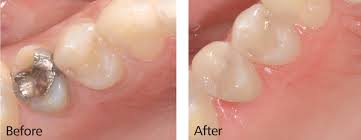
www.toxicteeth.org
Amalgam is interchangeable with numerous other filling
materials – including resin composites and glass ionomers – that have
rendered amalgam completely unnecessary for any clinical situation.
Always choose non-mercury fillings!
Selecting Non-Amalgam Dentistry
www.holisticdentalnetwork.com
This is the place where patients, consumers, and
Holistic professionals meet. You will find the answers to your questions
about mercury
toxicity, dental
amalgam health problems, heavy metal body burden, biocompatibility of
composite dental restorations, nonmetallic and non-mercury filings, protocols
for mercury amalgam removal, as well as biological microscopic
non-surgical gum care.
www.biosafedentistry.com
BioSafeDentistry is a method of “Green” natural
dentistry treating
you as the dental patient in a safer, healthier and less painful way than
conventional dentistry. BioSafeDentistry combines mercury
free dentistry, holistic dentistry and biological
dentistry with conventional
dental strategies. The combination of these safe
dentistry methods offers you a
safer, cleaner and healthier experience in your dental office.
-
A BioSafe Dentist is a Mercury
Free Dentist:
Mercury vapors are
extremely dangerous to your health. If you have mercury
amalgam fillings (any
silver colored filling in your tooth) the mercury vapor is being
released inside your body which can be inhaled, swallowed or absorbed
through the tissues in your mouth and lungs.
-
A BioSafe
Dentist uses Holistic
Dentistry and Biological
Dentistry. A BioSafeDentist never uses toxic materials or chemicals
while treating your dental needs. He only uses biocompatible materials
whenever possible.
-
BioSafeDentistry
is metal free dentistry-No
dangerous metals like mercury, nickel or beryllium are used to restore
your teeth. And toxic metals are safely removed from your teeth while
protecting your overall health.
-
A BioSafe
Dentist is a Fluoride Free
Dentist. Fluoride, which is harmful to children and adults, is not
used in your treatment.
-
A BioSafe
Dentist protects your entire body from mercury
vapors during amalgam fillings removal and
from other harmful metals that leak from other old tooth restorations
(like metal crowns).
-
A BioSafe Dentist
recommends nutritional supplementation to maintain and protect your
overall health. This is particularly true during and after mercury
fillings removal.
-
A BioSafe
Dentist uses state of the art high-efficiency air cleaners to capture
harmful mercury vapors that are released while your old mercury
fillings are removed.
top
To
Find a Mercury Free Dentist Near You
International
Academy of Oral Medicine & Toxicology (IAOMT)
- IAOMT member dentists are educated in biological dentistry including
techniques for proper removal of mercury fillings. Member physicians
appreciate the importance of biological dentistry in our overall health, and
are familiar with mercury detoxification methods.
International Academy of Biological Dentistry
and Medicine (IABDM) - Founded in 1985, the IABDM supports
dentists, physicians and all allied health practitioners who are committed
to integrating body, mind, spirit and mouth in caring for the whole person.
From clinical awareness and scientific study, we know that what happens in
the mouth is reflected in the body, and what happens in the body is
reflected in the mouth.
Holistic Dental Association - The
Holistic Dental Association is pleased to offer visitors a searchable
database of our membership.
Find a BioSafeDentist Dentist -
BioSafeDentistry combines mercury
free
dentistry, holistic dentistry and biological dentistry with
conventional dental strategies. The combination of these safe dentistry methods
offers you a safer, cleaner and healthier experience in your dental office.
www.mercuryfreenow.com
www.toxicteeth.org
top
Mercury In Fish
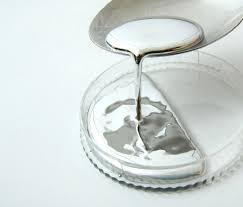
www.edf.org
- Copyright © Environmental Defense Fund. Used by permission.
Mercury is
released into the air primarily from industrial sources, falls to the ground in
rain or snow and is deposited into water bodies, where it is converted into
another highly toxic form of mercury (called methylmercury). Methlymercury then
builds up in the tissues of fish and other animals, and in high concentrations
can pose serious health risks to people who frequently eat contaminated fish.
Based on the available data on mercury concentrations in fish tissue,
Environmental Defense recommends limited consumption of certain fish (see
chart).
What
Are the Health Risks Associated With Consuming Mercury-Contaminated Fish?
Mercury
targets the nervous system and kidneys. Developing fetuses, infants and young
children are at the highest risk from mercury exposure, since their brains and
nervous systems are still forming. Fetuses can absorb mercury directly across
the placenta, and nursing infants can get it from their mother's breast milk.
This is why it is so important for women of childbearing age to minimize their
consumption of fish with high mercury levels. It can take 12-18 months for women
in their childbearing years to significantly rid their body burden of
methylmercury.
Children
exposed to mercury before birth may exhibit problems with mental development and
coordination, including how they think, learn and problem-solve later in life.
These neurological symptoms may appear similar to cerebral palsy. Developmental
and neurological damage can be irreversible for fetuses and young children, but
as children get older, the risk associated with mercury exposure decreases.
Mercury
exposure can also harm adults. Symptoms can include numbness, burning or
tingling of the extremities (lips, fingers, toes); fatigue; weakness;
irritability; shyness; loss of memory and coordination; tremors; and changes in
hearing and blurred vision. Extremely high mercury levels can permanently damage
an adult's brain and kidneys, or even lead to circulatory failure.
How
Can I Reduce the Risks of Eating Seafood Contaminated With Mercury?
Since
methylmercury binds to proteins, it is found throughout fish tissue, including
muscle tissue that makes up fish steaks and fillets. Therefore, cleaning and
cooking methods that can reduce amounts of other contaminants (like trimming fat
and removing skin and organs) are not successful in reducing mercury levels in
fish.
The best way
to reduce exposure to methylmercury is to moderate or eliminate your consumption
of predatory or long-lived fish (such as swordfish,
shark, orange
roughy and tuna).
Refer to Health
Alerts to see which species are known to have high levels of mercury.
Be especially conservative if you are a woman of childbearing age or are feeding
young children.
What
Fish Should I Avoid?
Fish low in
contaminants are an important part of a healthy diet. That's why Environmental
Defense recommends limited consumption of certain fish because of their
elevated mercury levels.
Reference - www.eurekalert.org
- University of Wisconsin-Madison -
Release date:
8-Mar-2007
Mercury contamination of fish warrants worldwide public warning:
The health risks posed by mercury contaminated fish is sufficient to warrant
issuing a worldwide general warning to the public — especially children and
women of childbearing age-to be careful about how much and which fish they eat.
That is one of the key findings comprising "The Madison Declaration on
Mercury Pollution" published today in a special issue of the international
science journal Ambio. Five other
major findings in the declaration were:
- On
average, three times more mercury is falling from the sky today than before
the Industrial Revolution 200 years ago as a result of the increasing use of
mercury and industrial emissions.
- The
uncontrolled use of mercury in small-scale gold mining is contaminating
thousands of sites around the world, posing long-term health risks to an
estimated 50 million inhabitants of mining regions. These activities alone
contribute more than 10 percent of the mercury in Earth's atmosphere
attributable to human activities today.
- Little
is known about the behavior of mercury in marine ecosystems and
methylmercury in marine fish, the ingestion of which is the primary way most
people at all levels of society worldwide are exposed to this highly toxic
form of mercury.
- Methylmercury
exposure now constitutes a public health problem in most regions of the
world.
-
Methylmercury
levels in fish-eating birds and mammals in some parts of the world are
reaching toxic levels, which may lead to population declines in these
species and possibly in fish populations as well.
To read more…www.eurekalert.org
Best
and Worst Seafood Choices (Downloadable Pocket Guides)
Link to
Non Toxic
www.edf.org
- Environmental Defense Fund
Seafood
Watch - Surf the
alphabetized list of seafood to find a particular kind and how
it's rated. Best – Ok – Worst for contaminated
top
Mercury
and Pollution Toxicity In Obesity
www.healthscience.org
-
National Health Association All rights reserved.
Research in England, Canada, and the United States suggests
that the most overweight people are found in cities and areas with the greatest
amount of industrial and environmental pollution.9 In the U.S., the 10 fattest
states are in the industrial South of our nation.10 They are connected either to
the Mississippi River, the most polluted river in the U.S., or in the case of
West Virginia, Texas, Alabama, Louisiana, and Georgia are home to some of the
top 20 mercury polluting power plants in the nation. While these areas may
foster lifestyles that support poor eating habits and sedentary behavior, it
appears that the increased levels of industrial pollutants may be contributing
to the epidemic of obesity independent of other factors.
Mines, refineries, and factories regularly release toxins
into the environment. Some of these pollutants are capable of disrupting key
biological hormones, affecting the fertility of mammals and invoking changes
that may be involved in reactive weight gain. Organochlorines — e.g., the
pesticides DDT, its’ breakdown product DDE, and PCB (found in farm-raised
salmon) — can decrease the levels of thyroid hormones, slowing down the
metabolic rate of the body, and interfering with weight loss. These pollutants
act directly on the sympathetic nervous system to interfere with
weight-regulating hormones, and the receptors on fat cells, that may be involved
in reactive weight gain.11
Some industrial pollutants like bisphenal-A, an estrogen
mimic used to make clear hard reusable plastic products, and flame retardants,
can signal dormant pre-adipocytes (baby fat cells) to grow into mature fat
cells.12 As fat cells grow, it is harder to keep weight down. This increase in
weight urges the detoxifying systems of the body to slow down and simply store
more and more toxins in the growing mass of available fat. As a result, the body
becomes increasingly fatter and more toxic. In some cases, these chemicals may
elicit inflammatory responses and toxic effects on brain, liver, and kidneys.13
This may eventually overwhelm the body’s detoxification pathways. Under this
pressure, the body tries to dilute these toxins by making new fat cells in which
to store them, since these chemicals are usually soluble in fat, thereby
reinforcing an ongoing cycle of toxicity, fat, and weight gain…read in its
entirety
www.healthscience.org
top
What Are Endocrine
Disruptors
www.epa.gov - U.S Environmental Protection Agency
Disruption of the endocrine system can occur in
various ways. Some chemicals mimic a natural hormone, fooling the body into
over-responding to the stimulus (e.g., a growth hormone that results in
increased muscle mass), or responding at inappropriate times (e.g.,
producing insulin when it is not needed). Other endocrine disrupting
chemicals block the effects of a hormone from certain receptors (e.g. growth
hormones required for normal development). Still others directly stimulate
or inhibit the endocrine system and cause overproduction or underproduction
of hormones (e.g. an over or underactive thyroid). Certain drugs are used to
intentionally cause some of these effects, such as birth control pills. In
many situations involving environmental chemicals, however, an endocrine
effect is not desirable.
Global Threat of
Endocrine
Disruptors
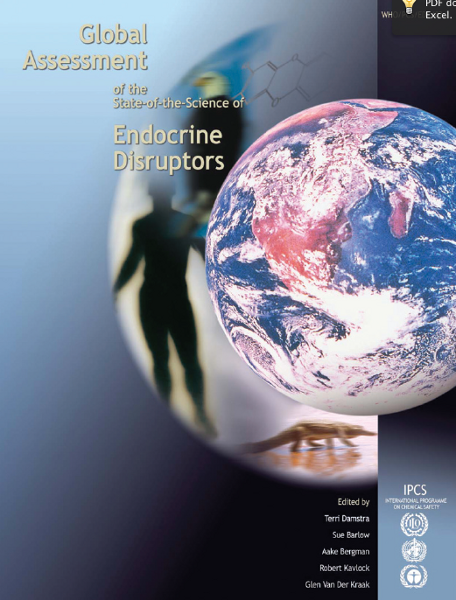
www.environmentalhealthnews.org
- Copyright © Environmental Health Sciences
United Nations Panel Calls Hormone Disruptors a
"Global Threat"
-
An international team of experts reported today that evidence
linking hormone-mimicking chemicals to human health problems has grown
stronger over the past decade, becoming a "global threat" that should be
addressed.
The U.S. Food and Drug Administration last year said
“the scientific evidence at this time does not suggest that the very low
levels of human exposure to BPA through the diet are unsafe.” The FDA and
U.S. Environmental Protection Agency are analyzing whether to restrict use
of the chemical, which is used in polycarbonate
plastic, canned food liners and some paper receipts.
The report also cites threats to wildlife, particularly
killer whales and harbour seals. Both have high levels of PCBs and flame
retardants that accumulate in ocean ecosystems.
One problem vexing those who study endocrine-disrupting
chemicals is the vast number of them – about 800 are known – and how they
may interact with one another. They’re in a variety
of things – such as pesticides, flame retardants, plastics, cosmetics and
canned foods – and research has only touched the “tip of the
iceberg,” according to the report…
A decade ago the biggest threat was thought to be
persistent organic pollutant chemicals – such as DDT and polychlorinated
biphenyls (PCBs). These chemicals – now banned in the United States --
traveled the globe, persisted in the environment and caused severe
population declines in some wildlife species…
Such contaminants still pose a threat. However, less
persistent but more ubiquitous chemicals found in everyday products – such
as bisphenol A (BPA) and phthalates – now are increasingly linked to human
health problems.
“These chemicals are what we call ‘pseudo persistent,”
said Tracey Woodruff, a professor at the University of California, San
Francisco, and a report co-author. “They don’t stay in the environment long
but people are exposed to them all the time so it’s the same effect as if
they were persistent.”…
To avoid prolonged exposures in the future, the panel
reported that perhaps countries should “ban or restrict chemicals in order
to reduce exposure early, even when there are significant but incomplete
data.”
“Frankly, for BPA, the science is done. Flame
retardants, phthalates … the science is done,” Zoeller said. “We
have more than enough information on these chemicals to make the reasonable
decision to ban, or at least take steps to limit exposure.”
But government agencies and industry groups remain
unconvinced.
The American Chemistry Council, which represents
chemical companies, has repeatedly questioned the validity of studies
linking two of the most pervasive endocrine
disruptors -- BPA and phthalates.
top
Hazards of
Endocrine
Disruptors
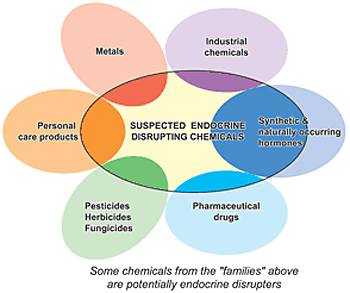
Source -
www.exrx.net
There remains an ongoing debate about the safety of
BPA, found in plastic bottles, food and beverage can linings, other food
containers and products. On one side, government-funded studies suggest this
compound contaminates our food and beverage to such an extent that they
interfere with our hormones and even our epigenome, increasing risks of
certain types of cancers and obesity, not only for the individual, but
possibly for his/her off spring. On the other side, chemical company funded
studies claim no such negative health effect.
Bisphenol A (BPA) Sources and Adverse Affects
-
Found in water bottles, baby bottles, plastic wraps, food and
beverage can liners, plastic food storage containers, DVDs and CDs,
Dental sealants, Impact-resistant plastics, cash register receipts, and more...
-
US Government's National Toxicology Program has concluded
that there is some concern at current exposure levels
-
Brain and behavioral effects on fetuses and young children
-
Political issues perpetuate ongoing debate and cloud health
concerns of BPA in adults
Bisphenol A is suspect of being linked to several
human epidemics
-
Cardiovascular Disease (PLoS ONE, Jan 13, 2010)
-
Type 2 diabetes
-
Breast and prostate cancers
-
Enlargement of prostate
-
Early onset of puberty
-
Obesity (Masuno 2002)
Bisphenol A is hormonally ‘active’.
-
It has an effect in cells at levels thousands of times lower
than toxicology reports had previously deemed safe (Nagel S)
-
Unlike phytoestrogens such
as those found in soy beans, bisphenol A does not bind to blood
proteins, which normally acts like a barrier, keeping estrogens from
entering the cell.
-
Bisphenal A has been shown to stimulate human breast-cancer
cells to proliferate in vitro (Welshons W)
-
Bisphenal A has been shown to enlarge prostates in mice at
dosages close to what humans are exposed to from sources such as food
packaging (Nagel S, Environmental Health Perspectives, National
Institute of Health, 1997)
-
Bisphenol A has been shown to lower sperm counts in mice
(Nagel S, 1997)
Exposure -
Bisphenol A enters
body
-
Digestion of contaminated water and food
-
Inhalation, entering through lungs
-
Skin contact (same way birth control does in patch form)
-
Mother’s blood stream to fetus
Studies by the CDC
found bisphenol A in the urine of 93%-95% of Americans (Calafat 2005, 2008)
Products containing bisphenol A
-
Plastic water bottles
-
Plastic food storage containers (ScienceNews, Aug 28, 2010)
-
US Food and Drug Administration approved BPA for use in food
containers in 1963
-
Over a decade later, federal law required safety reviews for
new chemicals
-
Plastic baby bottles (transparent plastic)
-
detachable nipples have also been found to contain trace
amounts of bisphenol A (Vom Saal)
-
Plastic resin in canned foods and aluminum beverage
containers (Consumer Reports, Dec 2009)
-
BPA has even been detected BPA-free cans (Consumer Reports,
Dec 2009)
-
Food containers from recycled paper (Ozaki)
-
Dental sealants, CDs and Toys, PVC pipe, medical equipment
(Consumer Reports, Dec 2009)
-
Impact-resistant plastics such as safety helmet, bulletproof
glass, traffic signals, computer cases (ScienceNews, Aug 28, 2010)
-
Cash register receipts (ScienceNews, Aug 28, 2010)
-
Found in approximately 80% of receipts (Environmental Working
Group, 2010)
-
Recycled paper
-
Gehring, et al. (2011). Bisphenol A contamination of
wastepaper, cellulose and recycled paper products, WIT eLibrary, 08
March 2011
The rate of bisphenol A leaching from plastic
containers into foodstuffs is accelerated by
-
Contact with lipids, such as those found in milk, formula,
cheese, meat, and vegetable oils
-
bisphenol A links to lipid molecules
-
Contact with acidic foods, such as fruit juice
-
Repeated washings
-
Exposure to heat or sunlight (Belcher)
Other environmental contaminants
-
Plastic pollutants in our lakes, streams, and oceans
-
Bisphenol A found in water
-
Suspect cause of unusually high instances of hermaphrodism in
wildlife (Tillitt D)
See Which
Plastics to Avoid
How Can You Reduce Your Exposure
top
Lead
www.niehs.nih.gov
- National Institute of Health
Today, the most
common sources of lead exposure in the United States are lead-based paint in
older homes, contaminated soil, household dust, drinking water, lead crystal,
and lead-glazed pottery. While extreme lead exposure can cause a variety of
neurological disorders such as lack of muscular coordination, convulsions and
coma, much lower lead levels have been associated with measurable changes in
children’s mental development and behavior. These include hyperactivity;
deficits in fine motor function, hand-eye coordination, and reaction time; and
lowered performance on intelligence tests.
Chronic lead exposure in adults can result in increased
blood pressure, decreased fertility, cataracts, nerve disorders, muscle and
joint pain, and memory or concentration problems. To read more…www.niehs.nih.gov
Lead
In Cosmetics
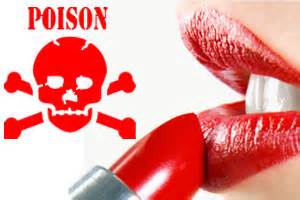
www.mindfully.org
- Lipsticks tested by
a U.S. consumer rights group found that more than half contained lead and some
popular brands including Cover Girl, L'Oreal and Christian Dior had more lead
than others….
The Campaign for Safe Cosmetics said tests on 33
brand-name red lipsticks by the Bodycote Testing Group in Santa Fe
Spring, California, found that 61 percent had detectable lead levels of 0.03 to 0.65
parts per million (ppm).
Search
to See If Your Cosmetics Are Toxic
www.cosmeticdatabase.com
-
Skin
Deep is a safety guide to cosmetics and personal care products brought to you by
researchers at the Environmental Working Group.
Skin Deep
pairs ingredients in more than 37,000 products against 50 definitive toxicity
and regulatory databases, making it the largest integrated data resource of its
kind.
www.safecosmetics.org
-
The Campaign for
Safe Cosmetics is a coalition of women’s, public health, labor, environmental
health and consumer-rights groups. Our goal is to protect the health of
consumers and workers by requiring the health and beauty industry to phase out
the use of chemicals linked to cancer, birth defects and other health problems,
and replace them with safer alternatives.
Household Lead
Checker
Homax (made in the USA) sells a Household Lead Checker –
Useful for the recent China recalled lead based products.
top
Non Toxic
Consumer Guides
www.ewg.org -
Consumer-Guides
[EWG]
The Environmental Working Group
offers you popular,
easy-to-use guides to help you choose products and foods that are free of
toxic ingredients, safe for your children and environmentally friendly.
Kids’ and babies’ developing bodies are especially vulnerable to chemicals
in the environment. Use EWG’s resources to learn how to avoid possible
hazards in the products that kids encounter.
What you use to clean your surroundings can affect
your health and the environment. EWG gives you the tools to make better
choices. Clean wisely.
View Consumer-Guides
top
Medical Imaging Radiation
Risks 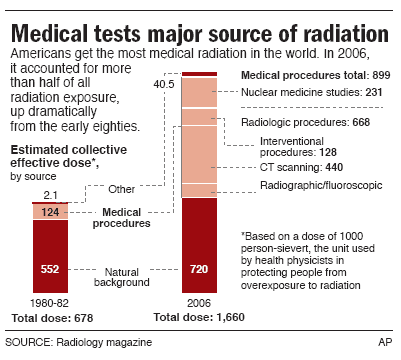
www.cancer.org - © American Cancer Society, Inc. All rights
reserved
There is a comment in the article that I think is
worthy of highlighting:
- “CT is generally considered to have a
very favorable risk to benefit profile among symptomatic
patients. However, the threshold for using CT has declined so that it
is no longer used only in very sick patients but also in those with
mild, self-limited illnesses who are otherwise healthy. In these
patients, the value of CT needs to be balanced against this small but
real risk of carcinogenesis resulting from its use. Neither physicians
nor patients are generally aware of the radiation associated with CT,
its risk of carcinogenesis, or the importance of limiting exposure among
younger patients, It is important to make both physicians and patients
aware that this risk exists.” (emphasis mine-By Dr.
Len)
These researchers also call on the profession to adopt
and put in place standards similar to those developed by the Food and Drug
Administration to monitor the performance of mammography machines to assure
patients and physicians that the doses being used are in fact the correct
and lowest dose needed for the CT scan. There
is currently no regulation of CT scans “in the field” at this time by the
FDA.
…In the first
study as reported in the Archives, the authors determined the number of
CT scans performed currently in the United States. Then, they estimated the
number of cancers that could eventually result from these scans.
They estimated that 72 million scans were performed in
this country in 2007. The highest cancer risks were for chest or abdomen CT
angiography (a study looking at blood vessels in the heart or aorta,
which is a large blood vessel in the chest and abdomen), and whole body CT
scans.
The researchers also noted that the risk of cancer
caused by CT scans declined as the patients got older.
They came to the conclusions that approximately
29,000 future cancers could be related to CT scans performed in 2007. Most
of this risk would come from the scans performed most often, namely CT scans
of the chest, abdomen and pelvis and head, as well as CT angiography of the
chest which looks for coronary artery disease.
www.fda.gov
As in many aspects of
medicine, there are risks associated with the use of X-ray imaging, which
uses ionizing radiation to generate images of the body. Ionizing radiation
is a form of radiation that has enough energy to potentially cause damage to
DNA. Risks from exposure to ionizing radiation include:
-
a small increase in the possibility that a person
exposed to X-rays will develop cancer later in life. (General
information for patients and health care providers on cancer detection
and treatment is available from the National
Cancer Institute.)
-
tissue effects such as cataracts, skin reddening,
and hair loss, which occur at relatively high levels of radiation
exposure and are rare for many types of imaging exams. For example, the
typical use of a CT scanner or conventional radiography equipment should
not result in tissue effects, but the dose to the skin from some long,
complex interventional fluoroscopy procedures might, in some
circumstances, be high enough to result in such effects.
Another risk of X-ray
imaging is possible reactions associated with an intravenously injected
contrast agent, or “dye”, that is sometimes used to improve visualization.
The risk of developing cancer from medical imaging
radiation exposure is generally very small, and it depends on:
-
radiation dose - The lifetime risk of cancer
increases the larger the dose and the more X-ray exams a patient
undergoes.
-
patient’s age - The lifetime risk of cancer is
larger for a patient who receives X-rays at a younger age than for one
who receives them at an older age.
-
patient’s sex - Women are at a somewhat higher
lifetime risk than men for developing radiation-associated cancer after
receiving the same exposures at the same ages.
-
body region - Some organs are more
radiosensitive than others.
... The medical community has emphasized radiation
dose reduction in CT because of the relatively high radiation dose for CT
exams (as compared to radiography) and their increased use, as reported in
the National
Council on Radiation Protection and Measurements (NCRP) Report No. 160.
Because tissue effects are extremely rare for typical use of many X-ray
imaging devices (including CT), the primary radiation risk concern for most
imaging studies is cancer; however, the long exposure times needed for
complex interventional fluoroscopy exams and resulting high skin doses may
result in tissue effects, even when the equipment is used appropriately. For
more information about risks associated with particular types of X-ray
imaging studies, please see the CT, Fluoroscopy, Radiography,
and Mammography web
pages.
top
Balancing Exam Imaging Benefits and Risks
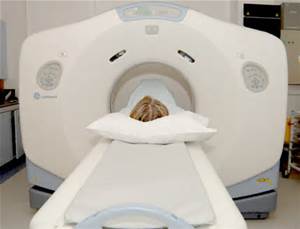
www.cancer.org - © American Cancer
Society, Inc. All rights reserved
Too many CT scans are not medically necessary, and
won’t impact the course of treatment for the patient. Too many CT scans
replace the history and physical and talking with the patient. Too many CT
scans are done because doctors are worried that they may be sued if they
don’t do it and something rare shows up later. Too many CT scans are done
because patients aren’t willing to take some responsibility for their health
and participate in the decision-making process.
All this “avoidance,” unfortunately, has now been
shown through this research and other similar reports to have a very real
cost, which is not just financial. It could be the cause of a future cancer
or even a death.
Doctors need to lead the way in reducing the risks of
these CT scan related problems.
They need to be certain the scan is truly needed. They
need to be certain that the CT scan machines are monitored carefully for the
amount of radiation they produce. They need to adhere to standards to be
certain that the dose of radiation used is the least required to get an
adequate study.
My friends, this is a serious problem. The awareness
of doctors and patients about the problem is long overdue.
Our technology can be terrific and can be lifesaving,
but only if used properly and carefully. It is critical that we be certain
that the CT scans we recommend and the CT scans we undergo be done only for
appropriate conditions and circumstances, where the benefits clearly
outweigh the risks.
www.fda.gov
While the benefit of a
clinically appropriate X-ray imaging exam generally far outweighs the risk,
efforts should be made to minimize this risk by reducing unnecessary
exposure to ionizing radiation. To help reduce risk to the patient, all
exams using ionizing radiation should be performed only when necessary to
answer a medical question, treat a disease, or guide a procedure. If there
is a medical need for a particular imaging procedure and other exams using
no or less radiation are less appropriate, then the benefits exceed the
risks, and radiation risk considerations should not influence the
physician’s decision to perform the study or the patient's decision to have
the procedure. However, the "As Low as Reasonably Achievable" (ALARA)
principle should always be followed when choosing equipment settings to
minimize radiation exposure to the patient.
top
Questions to Ask Your
Health Care Provider

Retrieved from -
mercola.com
The UC
Berkeley Wellness Letter offers some good suggestions for questions you
should ask before undergoing a diagnostic scan:
-
Is the test really necessary?
-
What difference will it make in my care?
-
Is there a non-radiation alternative, such as
ultrasound or MRI?
-
Is the facility accredited by the American
College of Radiology?
-
Will the test use the lowest level of radiation
for adequate imaging? (Will it be adjusted for my size, or my child’s
size?)
-
Will the scan be limited to the indicated area,
and will nearby areas be shielded?
www.fda.gov
Patients and parents of children undergoing X-ray
imaging exams should be well informed and prepared by:
Keeping track of medical-imaging histories as part of a
discussion with the referring physician when a new exam is recommended (see
the Image Wisely/FDA Patient
Medical Imaging Record card and "My
Child's Medical Imaging Record" card from the Alliance for Radiation
Safety in Pediatric Imaging).
top
Why X-Rays are So
Damaging to Your Health
Retrieved from -
mercola.com
There are four primary reasons that x-rays (and other
diagnostic tests that rely on ionizing radiation, such as mammograms and
CTs) should be minimized:
-
They cause chromosomal mutations that are often
irreparable, and the effects are cumulative.
-
They cause DNA changes that are proven to lead to
cancer.
-
They cause DNA damage in your arteries, which can
lead to cardiovascular disease.
-
They often result in misdiagnosis and false
positives, increasing the likelihood of follow up tests—further
increasing your radiation exposure.
One CT Scan is 100 Times More
Dangerous than Chest X-Ray
CT scans emit far more radiation than conventional
X-rays—a CT scan of the chest delivers 100 times the radiation of a
conventional chest X-ray, and a mammogram
delivers 1,000 times more radiation.
Over a ten-year period, a
woman can receive as much radiation exposure (5 rads) from routine
mammograms as a Japanese woman one mile from the epicenter of the atomic
bombs dropped on Hiroshima or Nagasaki.
Many nonessential radiation-based scans could be
eliminated altogether.
top
Natural Ways to Help You Strengthen Your Body Against the Assaults of
Medical Radiation
In addition to seeking to avoid unnecessary radiation
exposure and using the safest medical testing available whenever you do need
a medical image test, you may be able to lower your radiation-induced risk
for cancer by using a potent antioxidant. If, for whatever reason you are
forced into a CT scan, this is the best advice I can give you, to protect
yourself from this massive ionizing radiation exposure…
Astaxanthin is a potent
carotenoid and everything I have studied suggests it is the most potent
antioxidant to protect against this type of damage. You can take 2-4 mg of
astaxanthin to protect your cells and tissues. The downside, however, is
that you need to be on it for several weeks to prevent the damage.
The side benefit is that the astaxanthin will also
likely prevent the most common cause of blindness, age related macular
degeneration, cataracts and also help you from getting sunburned.
top
|

|
